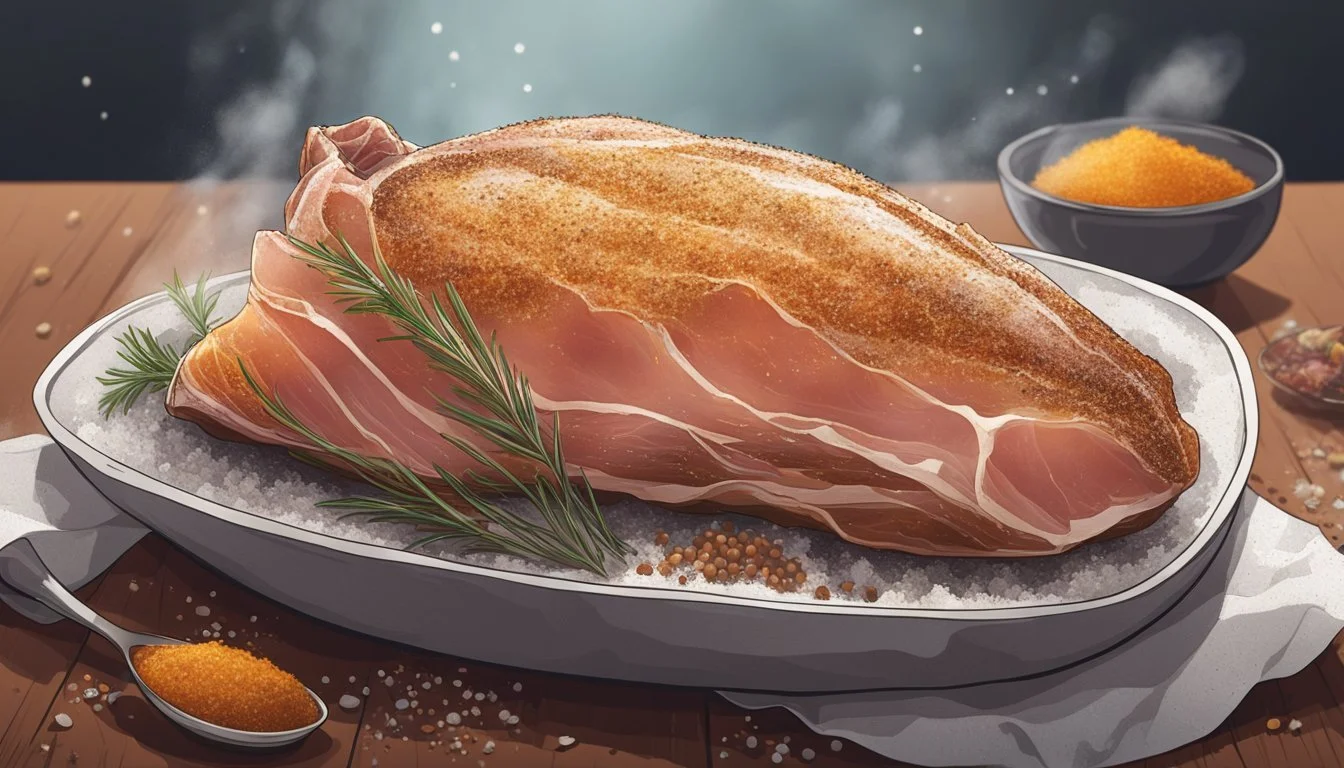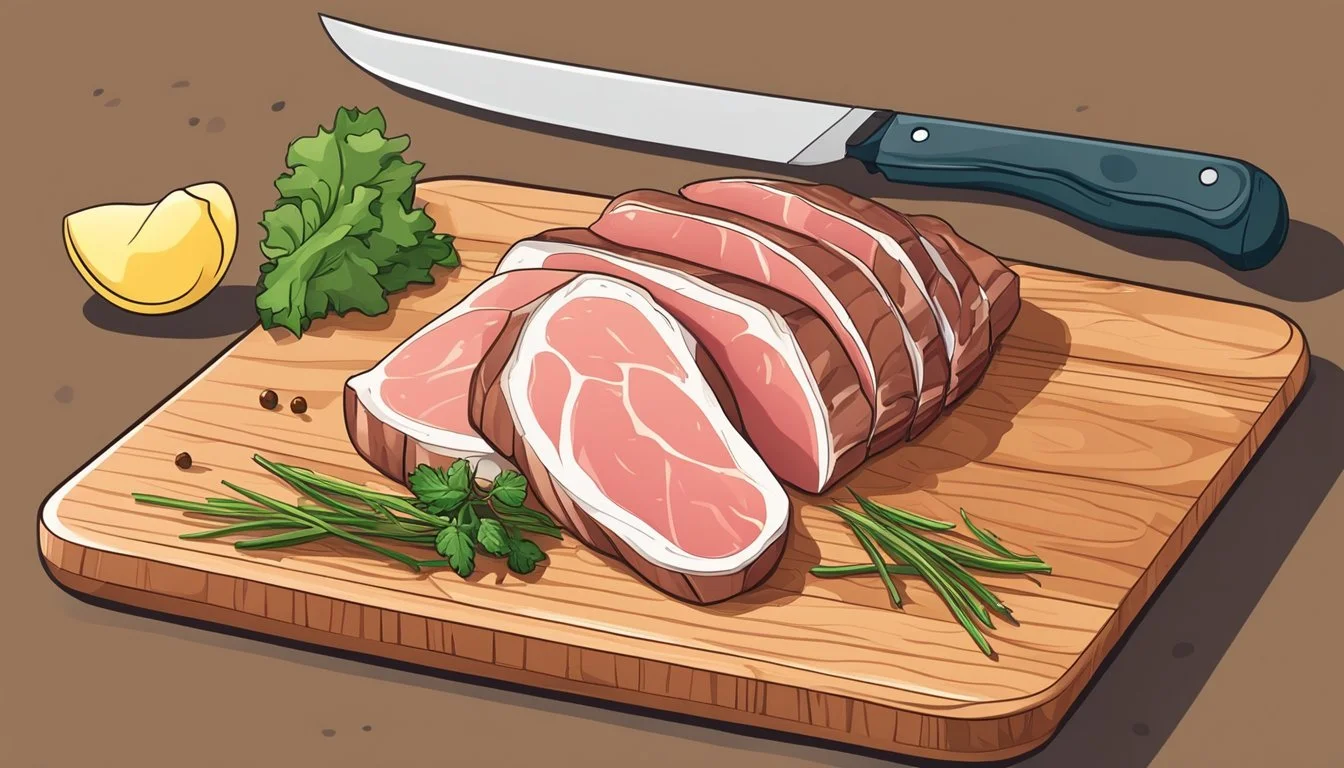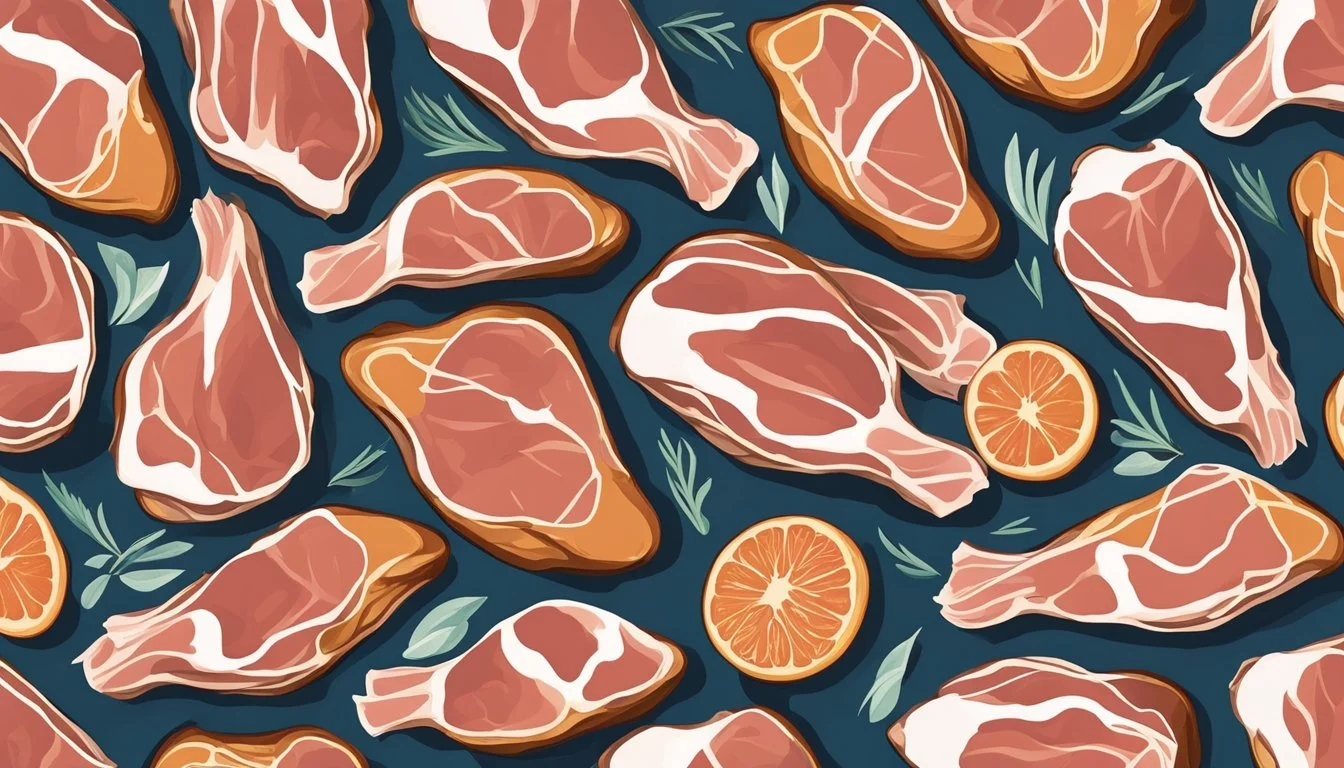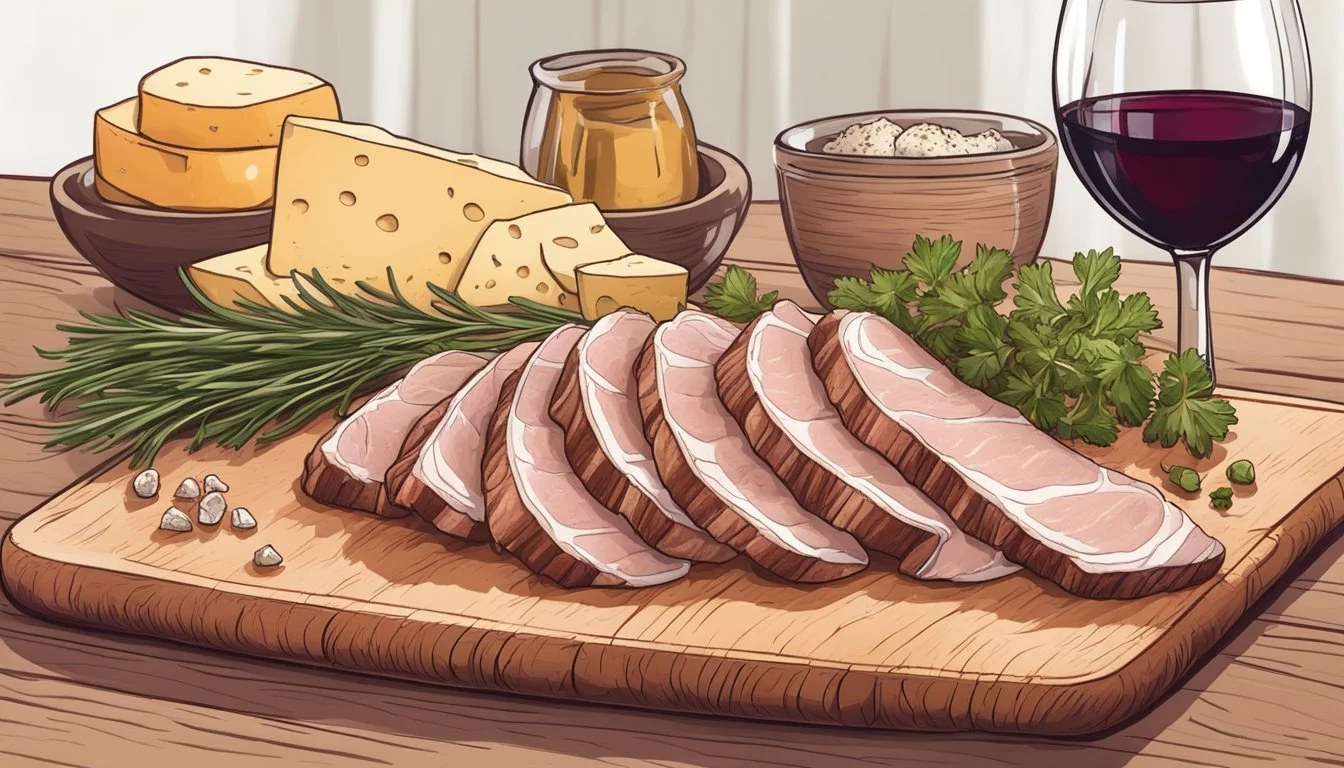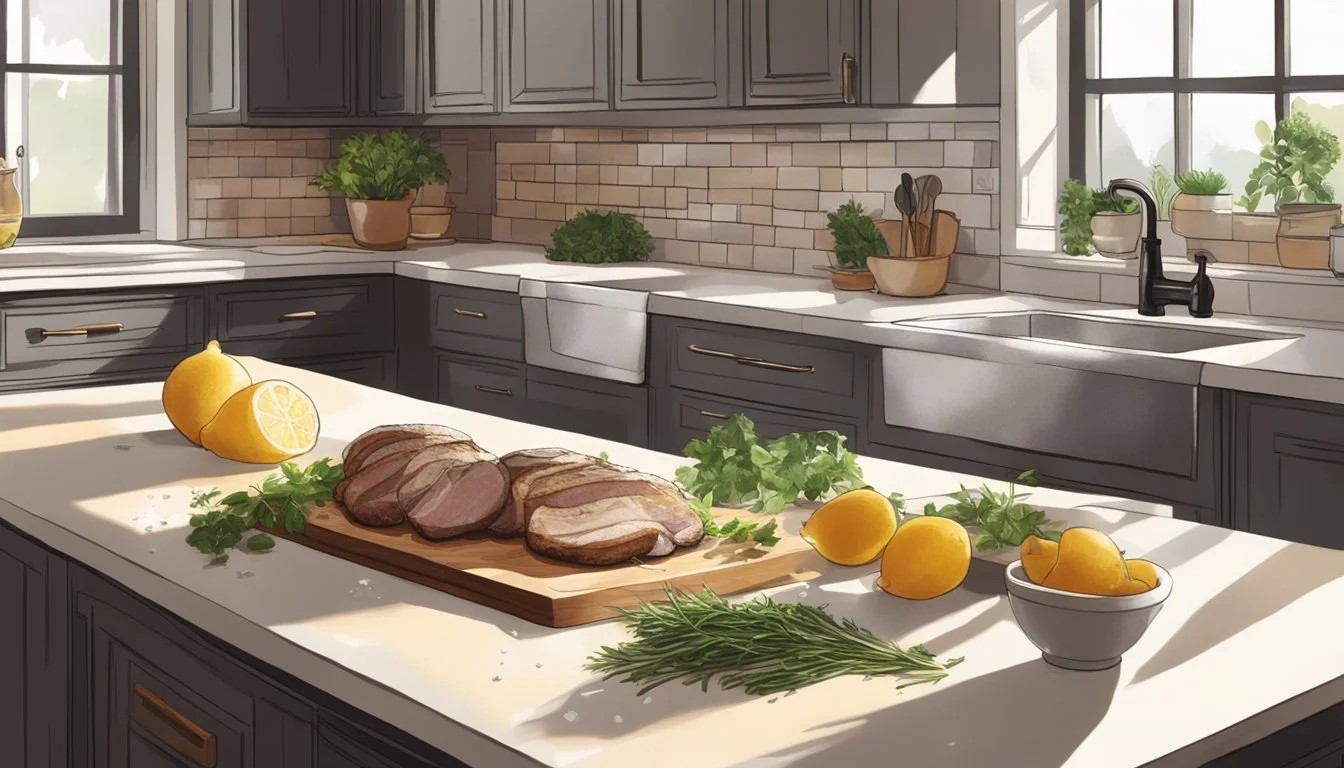fHow to Make Duck Breast Prosciutto at Home
Simple Techniques for Delicious Charcuterie
Duck breast prosciutto is an exquisite delicacy that has found its way into home kitchens where culinary enthusiasts seek to recreate the rich, savory flavors traditionally associated with Italian charcuterie (What wine goes well with charcuterie?). This specialty involves curing the breast meat of ducks, transforming it into a tender, flavorful prosciutto that can rival its pork counterpart. The process not only imparts a unique taste but also pays homage to the age-old practice of meat preservation.
Making duck prosciutto at home is an accessible venture for beginners, offering an introduction to the world of curing meats without the need for specialized equipment. The technique centers around salt curing, a method that is both simple and effective, and requires only a few ingredients alongside the duck breasts. With patience and adherence to guidelines, home chefs can yield a delectable product that adds a gourmet touch to their culinary creations.
A beginner's guide serves as a roadmap, outlining essential steps such as choosing the right quality of duck, preparing the cure, and the critical curing times involved. With the proper approach, enthusiasts learn how to achieve the desired firmness and flavor profile, ensuring their homemade duck prosciutto is a successful and satisfying endeavor.
The Basics of Prosciutto and Its Origins
Prosciutto is a type of Italian dry-cured ham that is usually sliced thin and served uncooked. This specialty has a protected designation of origin (PDO), with the most renowned types being Prosciutto di Parma, Prosciutto di San Daniele, and Prosciutto Toscano. The term "prosciutto" is derived from the Latin "perexsuctum", which translates to "dried out".
The origins of prosciutto can be traced back to pre-Roman times. Historical documentation suggests that the process of air-curing pork legs was already established in Italy. Regions with specific microclimates, like Parma and San Daniele, became particularly famous for their dry-cured hams. The production techniques have evolved, but the essence of making prosciutto remains rooted in traditional methods.
Prosciutto di Parma is known for its delicate flavor and slightly nutty aroma, hailing from the Parma region of Italy. In contrast, Prosciutto di San Daniele, from the Friuli Venezia Giulia region, is characterized by its darker color and sweeter taste, influenced by the microclimate of San Daniele del Friuli. Prosciutto Toscano carries a strong aroma and is more heavily seasoned, signifying the flavors of Tuscany.
Italian law strictly regulates the production of these hams, dictating the diet of the pigs, the environmental conditions of processing, and the length and conditions of the aging process. This attention to detail ensures the high quality and authenticity of Italian prosciutto. These regulations help preserve the method that has been part of Italy’s gastronomic heritage for centuries.
Understanding Duck Breast for Prosciutto
When making duck prosciutto, choosing the right duck breast and understanding its characteristics are crucial for creating a delicate, flavorful cured meat.
Selecting Quality Duck Breast
One must be meticulous in selecting quality duck breasts for prosciutto. Ideally, the breasts should come from well-raised ducks, ensuring the meat is tender and flavorful. One should look for breasts that have:
A uniform pinkish hue, without any discoloration
Skin that is intact and free from punctures or tears
A layer of fat that is consistent and ample, which will aid in the curing process
The Role of Fat and Tenderness
The fat on a duck breast plays a pivotal role in the texture and taste of the finished prosciutto. A well-cured duck breast prosciutto should have:
Fat that is rendered soft yet firm, contributing to a smooth texture and serving as a vehicle for the flavors of the cure.
Meat that is adequately tender, which becomes distinctly more flavorful and nuanced after the curing process.
The fat not only influences the end product's richness but also aids in the curing process, helping to evenly distribute the curing agents and maintaining the meat's moisture balance.
Ingredients and Supplies
To craft exquisite duck prosciutto at home, one must meticulously select quality salts, accentuating spices, and essential curing equipment. Precision in this initial phase ensures a successful and flavorful outcome.
Choosing the Right Salt
A fundamental choice in curing duck breast is the selection of salt. Sea salt or kosher salt is suitable due to their pure, natural composition and ability to draw out moisture effectively. It is advisable to avoid table salt as it often contains additives that can affect the curing process.
Sea Salt: Unrefined, retains trace minerals for flavor.
Kosher Salt: Pure, with larger grains ideal for curing.
Herbs and Spices for Flavor
Spices and herbs are vital for adding depth to the duck prosciutto's flavor profile. Classic options include:
Black Pepper: Freshly cracked for a piquant kick.
Thyme: Dried, for a subtle, earthy undertone.
Juniper Berries: Crushed, to impart a distinct aromatic element.
Combining these with the salt cure creates a balanced and savory taste that complements the duck breast.
Additional Equipment Needed
Curing requires specific tools and materials to ensure the process is both effective and safe. These are the essentials one will need:
Vacuum Sealer and Bags: To tightly seal the duck breasts and ensure they are properly cured.
For those without a traditional vacuum sealer, Umai Dry® Bags can be used in combination with a VacMouse® Channel Vacuum Adapter to achieve a similar seal.
Sharp Knife: Necessary for scoring the duck breast skin, which allows for better salt penetration and even drying.
A non-reactive container or tray for holding the duck breasts during the initial curing phase is also important.
With these ingredients and tools on hand, one is set to create a homemade duck prosciutto that rivals any artisanal offering.
The Curing Process
The curing process transforms duck breast into a savory delicacy known as prosciutto through a series of carefully controlled steps. Precise measurements and hygiene practices are crucial for safety and quality.
Preparing the Spice Cure
Before beginning the curing process, one must prepare a spice cure mixture. The spice cure typically consists of a precise ratio of salt, with 2.75% salt to the weight of the duck breast being the standard. Additionally, 0.25% Cure #2 is often included for its preservative properties. This mixture may also contain sugar and aromatics such as thyme, which are mixed in a large bowl. It is essential to coat each duck breast thoroughly, ensuring the mixture covers and penetrates all sides of the meat.
Curing the Duck Breast
After applying the spice cure, the duck breasts are placed in a non-reactive container or a vacuum-seal bag to contain the moisture and cure evenly. The curing time in the refrigerator can range from 24 hours to a week depending on the desired taste and texture. During this period, one should massage the cure into the meat daily and ensure that it remains completely covered with the curing mix.
Equilibrium Curing Explained
Equilibrium curing is a method that aims for a balanced distribution of salt without the risk of excess curing. It involves using the exact amount of curing mixture needed to cure the duck breast with minimal waste. The weight of the meat dictates the precise quantity of salt and Cure #2, allowing for an even cure that does not overpower the natural flavors of the duck.
Managing Mold and Bacteria Risks
During the curing process, it's crucial to monitor the duck breast for any signs of harmful mold or bacteria. Curing should be done in a controlled environment, often referred to as a curing chamber, which maintains a specific humidity and temperature. This environment not only aids in the development of beneficial mold that can improve flavor and texture but also minimizes the risks associated with foodborne illnesses. Regularly checking the meat throughout the curing process and using the safest known methods for drying and curing are integral to ensuring the highest quality and safety of the finished prosciutto.
Drying and Aging the Meat
The drying and aging process is essential in developing the distinct flavors and textures of homemade prosciutto. Achieving the perfect balance of temperature and humidity is key to ensuring the meat cures properly without spoiling.
Setting Up a Drying Environment
To setup a drying environment, one should look for a space that is cool, dark, and well-ventilated. A regular refrigerator can be adapted for use by designating the vegetable drawer as the drying space. It is crucial to ensure there is enough room for air to circulate around the meat, so placing it on a drying rack within this drawer is ideal. The goal is for the duck breast to be air dried without touching other surfaces or foods.
Temperature and Humidity Control
Controlling the temperature and humidity is critical when drying and aging prosciutto. The ideal temperature range is between 50°F to 60°F, with a humidity level of 60% to 70%. These conditions mimic those of a traditional charcuterie aging environment. For those using a regular fridge, one may need to use a hygrometer to monitor the humidity levels and make adjustments as necessary to maintain the appropriate climate. Consistent conditions prevent the meat from drying out too quickly or developing harmful bacteria.
Determining Adequate Aging Time
The aging time for duck prosciutto typically varies from two to four weeks. One of the telltale signs that the prosciutto is properly aged is weight loss; the meat should lose approximately 30% of its original weight. The feel of the meat is also an indicator; when it becomes firm to the touch, the aging process has likely been successful. However, flavors develop fully when the meat is given enough time to age, so patience is essential for producing a richly flavored, dry-cured prosciutto suitable for a charcuterie plate.
Finishing Steps: Trimming and Storage
After the duck breast has been cured, precise trimming and proper storage are essential to ensure quality and longevity of your homemade duck prosciutto.
How to Trim Your Duck Prosciutto
Once the curing process is complete, the duck breast should be firm to the touch. They should then gently rinse off any excess salt under cold water and pat the meat dry with towels. Careful trimming is the next step; one must remove any excess fat that didn't render out during the drying phase, as it can become rancid over time. The goal is to leave a thin, even layer of fat, about 1/8-inch thick, to preserve the moisture and flavor.
Rinse: Remove excess salt under cold water.
Pat Dry: Use clean towels to dry the duck breast thoroughly.
Trim: Cut away extraneous fat, aiming for a consistent thin layer.
Proper Storage Techniques
For short-term storage, wrap the duck prosciutto in either wax paper or butcher paper and then place it in the refrigerator. However, for longer storage, one should consider vacuum sealing it to protect against airborne contaminants and moisture loss. If a vacuum sealer isn't available, it should be tightly wrapped in wax paper, then wrapped again in a clean cloth, and stored in the coolest part of the refrigerator.
For those interested in aging the prosciutto further, it can be hung in a cool, humidity-controlled environment; this will continue the drying process and intensify the flavors.
Refrigerate: For short term, wrap and refrigerate.
Vacuum Seal: For prolonged storage, vacuum sealing is preferable.
Hang: Additional aging can be done by hanging in a controlled environment.
Serving and Pairings
When serving duck breast prosciutto, it is crucial for the eater to experience its delicate flavor and texture. Careful slicing and thoughtful pairings enhance these aspects, turning simple tasting into an exquisite experience.
Cutting and Presentation
Duck breast prosciutto should be sliced thinly, almost translucently if possible. This allows for the rich flavors to be appreciated with each delicate bite. A sharp knife or a meat slicer can achieve this level of thinness. Once sliced, it should be arranged neatly on a platter, often overlapped slightly, showcasing the deep red hue of the meat against the white fat. For an added touch of elegance, it can be drizzled with a little high-quality balsamic vinegar or served on a wooden board for rustic appeal.
Ideal Food Pairings
Duck prosciutto pairs exceptionally well with a variety of foods. Here are some specific pairings that elevate the dish:
Cheeses: A sharp Parmesan cheese complements the prosciutto's depth of flavor.
Fruits: Fresh or grilled peaches, ripe figs, or sweet melon slices create a pleasant contrast with the savory and salty prosciutto.
Salads: Incorporate into salads featuring arugula, mushrooms, or other vegetables for a hearty appetizer.
Appetizers: (What wine goes well with appetizers?) It can be served on a charcuterie board or as the star of elegant appetizers.
Sandwiches and Dishes: Adding prosciutto to sandwiches gives a gourmet twist; it can also be chopped and added to main dishes for a punch of flavor.
By considering these pairings, the overall culinary experience is enriched, making for memorable appetizers and dishes.
Safety and Best Practices
When making duck breast prosciutto at home, adhering to safety measures is crucial to ensure the final product is both delicious and safe to consume. Educating oneself on the safest known methods is the first step.
Meat Selection and Handling:
Always start with fresh, high-quality duck breast.
Keep the meat refrigerated until it's time to cure.
Maintain a clean workspace to minimize the risk of contamination.
Curing Process:
Use non-reactive containers for curing.
Accurately measure 2.75% salt to the weight of the duck breast.
For added safety, include 0.25% Cure #2, which contains nitrates, helping to prevent harmful bacteria growth.
Temperature Control:
A reliable thermometer is essential to monitor the temperature, keeping it consistently between 35°F and 40°F during curing.
Case Hardening Prevention:
To prevent case hardening, which is a dried outer layer that prevents even drying throughout, ensure the duck breast is not exposed to too high temperatures or airflow.
Dry-Cured Ham Similarities:
Like dry-cured ham, the process is slow and requires patience. Rushing can compromise safety.
Storage and Maturation:
After curing, the duck breast should be wrapped in cheesecloth and hung in a cool, well-ventilated environment at 55°F to 60°F with 60-75% humidity.
Check regularly for any signs of spoilage or an unusual smell.
By following these guidelines, individuals can confidently create their own duck breast prosciutto while mitigating risks for a safe and enjoyable experience in charcuterie.
Creative Variations and Experimentation
When making duck breast prosciutto, home chefs can infuse personal touches that transform the basic recipe into a signature dish. The process is versatile, allowing for a range of flavors from classic to inventive.
Flavor Profiles: One can experiment with various spices to elevate the flavor. For instance, adding juniper berries can provide a piney note, while pink peppercorns lend a gentle, fruity spice. Home curers often incorporate a combination of herbs such as rosemary and thyme for an aromatic touch.
Sweet Twists: To add a sweet dimension, consider blending a small amount of brown sugar or maple syrup into the cure. The sugars can create a pleasing balance to the saltiness inherent in prosciutto.
Smoked Variations: For those who prefer a smoky taste, incorporating smoked salt or a brief session in a smoker can impart a subtle smokiness. This additional step can make a significant impact on the final product, providing a depth of flavor similar to traditional smoked meats.
Spice Sweet Smoked Juniper Brown Sugar Smoked Salt Pink Peppercorn Maple Syrup Smoker Use Rosemary and Thyme Honey -
Experimentation Dos and Don'ts:
Do start with small quantities of additional flavors to ensure they complement rather than overwhelm the duck.
Don’t forget that curing is an exercise in precision; maintain the correct salt-to-meat ratio.
Remember, every addition should respect the delicate balance required for curing meat to achieve that perfect harmony between savory, sweet, and aromatic.
Understanding the Cultural Significance
Duck prosciutto, often associated with traditional Italian cuisine, is a nod to the longstanding tradition of curing meats that dates back to ancient times. The origin of prosciutto is linked to the Latin term perexsuctum, meaning "dried" or "dehydrated." Italian artisans have perfected this craft over centuries, particularly pig prosciutto, which is a staple in Italian feasts and banquets.
During the Renaissance, the art of curing meats turned into a culinary standard, indicative of an era that celebrated fine food and elaborate dining experiences. Duck breast prosciutto, while less traditional than its pork counterpart, shares these roots and represents the versatility and adaptation of culinary practices over time.
Literature and history have often referenced these delicacies, underscoring their importance as both food staples and indicators of cultural sophistication. These references also highlight the significance of such dishes in social gatherings and their roles in fostering community bonds.
In contemporary cuisine, the preparation of duck prosciutto at home connects enthusiasts with a piece of culinary history, blending ancient techniques with modern-day accessibility.
Italian Feast: Integral to celebration and hospitality
Latin Origins: Derives from methods to preserve meats
Renaissance Influence: Symbol of culinary artistry and refinement
This delicacy has thus transcended time, from banquet tables of nobility to modern kitchens, without losing its cultural essence.


